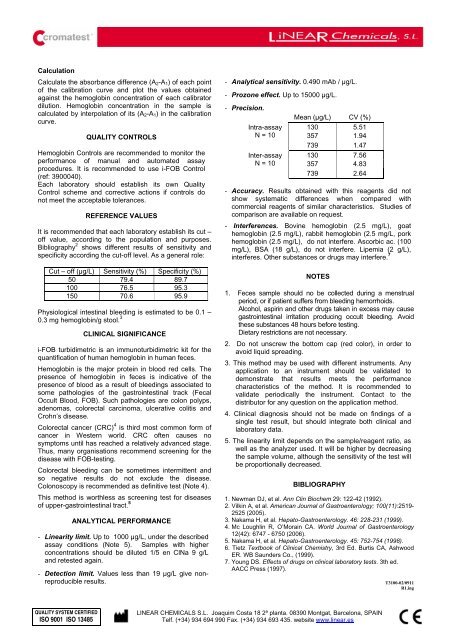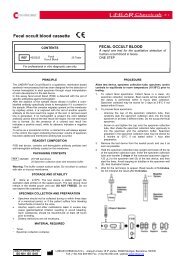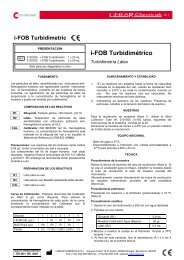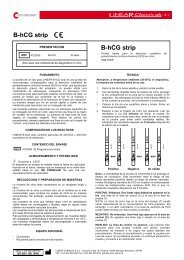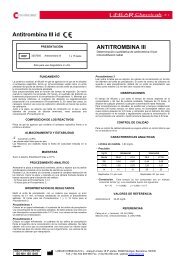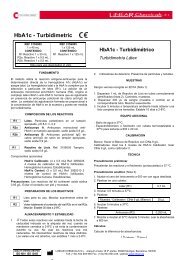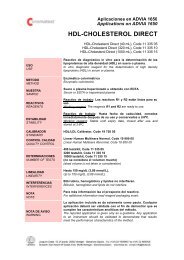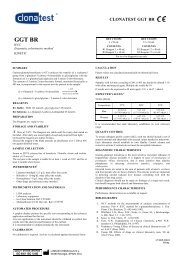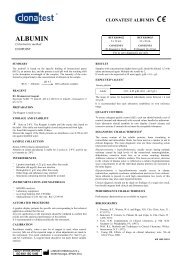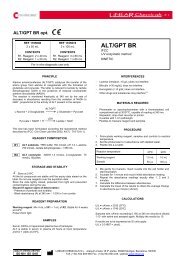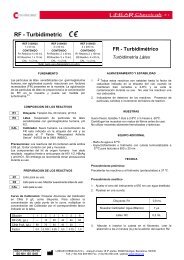i-FOB Turbidimetric - Linear
i-FOB Turbidimetric - Linear
i-FOB Turbidimetric - Linear
Create successful ePaper yourself
Turn your PDF publications into a flip-book with our unique Google optimized e-Paper software.
CalculationCalculate the absorbance difference (A 2 -A 1 ) of each pointof the calibration curve and plot the values obtainedagainst the hemoglobin concentration of each calibratordilution. Hemoglobin concentration in the sample iscalculated by interpolation of its (A 2 -A 1 ) in the calibrationcurve.QUALITY CONTROLSHemoglobin Controls are recommended to monitor theperformance of manual and automated assayprocedures. It is recommended to use i-<strong>FOB</strong> Control(ref: 3900040).Each laboratory should establish its own QualityControl scheme and corrective actions if controls donot meet the acceptable tolerances.REFERENCE VALUESIt is recommended that each laboratory establish its cut –off value, according to the population and purposes.Bibliography 2 shows different results of sensitivity andspecificity according the cut-off level. As a general role:Cut – off (µg/L) Sensitivity (%) Specificity (%)50 79.4 89.7100 76.5 95.3150 70.6 95.9Physiological intestinal bleeding is estimated to be 0.1 –0.3 mg hemoglobin/g stool. 3CLINICAL SIGNIFICANCEi-<strong>FOB</strong> turbidimetric is an immunoturbidimetric kit for thequantification of human hemoglobin in human feces.Hemoglobin is the major protein in blood red cells. Thepresence of hemoglobin in feces is indicative of thepresence of blood as a result of bleedings associated tosome pathologies of the gastrointestinal track (FecalOccult Blood, <strong>FOB</strong>). Such pathologies are colon polyps,adenomas, colorectal carcinoma, ulcerative colitis andCrohn’s disease.Colorectal cancer (CRC) 4 is third most common form ofcancer in Western world. CRC often causes nosymptoms until has reached a relatively advanced stage.Thus, many organisations recommend screening for thedisease with <strong>FOB</strong>-testing.Colorectal bleeding can be sometimes intermittent andso negative results do not exclude the disease.Colonoscopy is recommended as definitive test (Note 4).This method is worthless as screening test for diseasesof upper-gastrointestinal tract. 5ANALYTICAL PERFORMANCE- <strong>Linear</strong>ity limit. Up to 1000 µg/L, under the describedassay conditions (Note 5). Samples with higherconcentrations should be diluted 1/5 en ClNa 9 g/Land retested again.- Detection limit. Values less than 19 µg/L give nonreproducibleresults.- Analytical sensitivity. 0.490 mAb / µg/L.- Prozone effect. Up to 15000 µg/L.- Precision.Mean (µg/L) CV (%)Intra-assay 130 5.51N = 10 357 1.94739 1.47Inter-assay 130 7.56N = 10 357 4.83739 2.64- Accuracy. Results obtained with this reagents did notshow systematic differences when compared withcommercial reagents of similar characteristics. Studies ofcomparison are available on request.- Interferences. Bovine hemoglobin (2.5 mg/L), goathemoglobin (2.5 mg/L), rabbit hemoglobin (2.5 mg/L, porkhemoglobin (2.5 mg/L), do not interfere. Ascorbic ac. (100mg/L), BSA (18 g/L), do not interfere. Lipemia (2 g/L),interferes. Other substances or drugs may interfere. 7NOTES1. Feces sample should no be collected during a menstrualperiod, or if patient suffers from bleeding hemorrhoids.Alcohol, aspirin and other drugs taken in excess may causegastrointestinal irritation producing occult bleeding. Avoidthese substances 48 hours before testing.Dietary restrictions are not necessary.2. Do not unscrew the bottom cap (red color), in order toavoid liquid spreading.3. This method may be used with different instruments. Anyapplication to an instrument should be validated todemonstrate that results meets the performancecharacteristics of the method. It is recommended tovalidate periodically the instrument. Contact to thedistributor for any question on the application method.4. Clinical diagnosis should not be made on findings of asingle test result, but should integrate both clinical andlaboratory data.5. The linearity limit depends on the sample/reagent ratio, aswell as the analyzer used. It will be higher by decreasingthe sample volume, although the sensitivity of the test willbe proportionally decreased.BIBLIOGRAPHY1. Newman DJ, et al. Ann Clin Biochem 29: 122-42 (1992).2. Vilkin A, et al. American Journal of Gastroenterology; 100(11):2519-2525 (2005).3. Nakama H, et al. Hepato-Gastroenterology. 46: 228-231 (1999).4. Mc Loughlin R, O’Morain CA. World Journal of Gastroenterology12(42): 6747 - 6750 (2006).5. Nakama H, et al. Hepato-Gastroenterology. 45: 752-754 (1998).6. Tietz Textbook of Clinical Chemistry, 3rd Ed. Burtis CA, AshwoodER. WB Saunders Co., (1999).7. Young DS. Effects of drugs on clinical laboratory tests. 3th ed.AACC Press (1997).T3100-02/0911R1.ingQUALITY SYSTEM CERTIFIEDISO 9001 ISO 13485LINEAR CHEMICALS S.L. Joaquim Costa 18 2ª planta. 08390 Montgat, Barcelona, SPAINTelf. (+34) 934 694 990 Fax. (+34) 934 693 435. website www.linear.es


